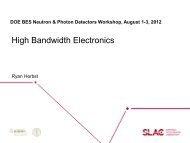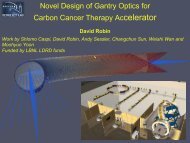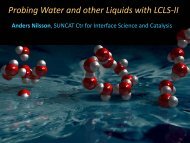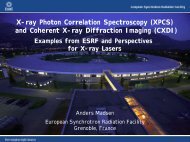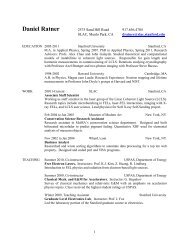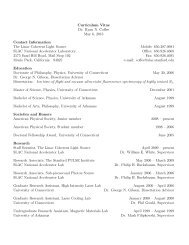SXR Technical Design Report - Stanford University
SXR Technical Design Report - Stanford University
SXR Technical Design Report - Stanford University
You also want an ePaper? Increase the reach of your titles
YUMPU automatically turns print PDFs into web optimized ePapers that Google loves.
5.10 Intensity Monitors:<br />
The spectrum as well as the intensity of LCLS will fluctuate due to the SASE process. LCLS provides<br />
measurements of the number of photons on a shot by shot basis. As the spectrum of LCLS fluctuates<br />
beyond the spatial resolution of the monochromator, it is essential to measure the beam intensity after the<br />
slit assembly on a shot by shot basis to normalize measured spectra. The intensity monitor need only be<br />
relative and linear over a short energy range, on the order of 10 eV. A signal to noise ratio of 0.1% is<br />
needed.<br />
A gas cell can exceed these requirements. Such a cell should be windowless to preserve the coherence of<br />
the FEL beam. such a cell is complex to design and expensive construction and is not in the scope of the<br />
first experiments. Space between the slit assembly and the first focusing mirror tank should be kept clear as<br />
far as possible for future use by a future gas cell monitor.<br />
The use of an in-vacuum photo diode to measure the fluorescent and scattered radiation from an optical<br />
element will be implemented inside the second focusing mirror tank. Similar intensity monitors have been<br />
implemented successfully at beam lines at SSRL. Scaling from the SSRL data and assuming 1*10^12<br />
photons per pulse, there would be 0.5x10^6 photon per pulse in the diode, at 800 eV this would be 1*10^8<br />
electrons per pulse which should approximately 0.15% signal to noise. For better statistics either the diode<br />
could be moved closer to the mirror, i.e. make detector more position sensitive, or use several diodes, to<br />
make it less position sensitive. As these detectors are only collecting scattered radiation from optics, they<br />
are non-destructive to the beam. Such detectors can configured specifically to be beam position monitors.<br />
The photocurrent from a thin Aluminum foil has been implemented successfully at FLASH to be used as an<br />
intensity monitor for the fifth harmonic. The radiation after the monochromator is attenuated by two orders<br />
of magnitude and is not expected to destroy the foil. The aluminum foil assembly will be mounted on a<br />
motorized linear feed-through which allows one to insert and remove the assembly into / from the beam. A<br />
ring electrode at +1kV around the beam separated from the foil by 2mm is used to collect the photo<br />
electrons, avoiding non-linearity caused by space charge effects. The Al foil itself is connected to a charge<br />
sensitive amplifier through a coaxial cable and the detected signal is digitized at 120 Hz, synchronously to<br />
the repetition rate of LCLS. The Al foil will be 200nm thick (commercially available). Beryllium foils are<br />
also an option.<br />
5.11 Refocusing Mirrors:<br />
Refocusing optics are required that image the exit slit vertically, and the source horizontally at the second<br />
experimental position. The configuration from section 3 is to put these mirrors close to the final focus<br />
while being compatible with differential pumping and experimental chamber dimensions.<br />
The proposed imaging system will be a K-B pair of elliptical cylinders. The elliptical cylinders will be<br />
generated by bending optical flats that have a profiled width and independent moments applied at each end.<br />
The mirror system shall be able to adjust from essentially unfocused to fully focused at the sample position.<br />
The mechanical design is to be very similar to that used for the AMO focusing mirrors with the exception<br />
that they do not need to be removed from the beam. The M2 and M3 mirrors are to be operated at<br />
essentially fixed angles of incidence. A fixed aperture will be located down beam of the M3 Mirror to<br />
contain the beam. Thus the components between the M3 and the focus can be fixed in space.<br />
The K-B mirror system will be a clone of the AMO system with the exception that the profiles of the<br />
mirrors will be optimized for the focal lengths on the <strong>SXR</strong> beam line. The mirrors will be at a nominal<br />
grazing angle incidence of 13.85 mrad and fabricated from single crystal silicon with a B 4 C optical coating.<br />
26



